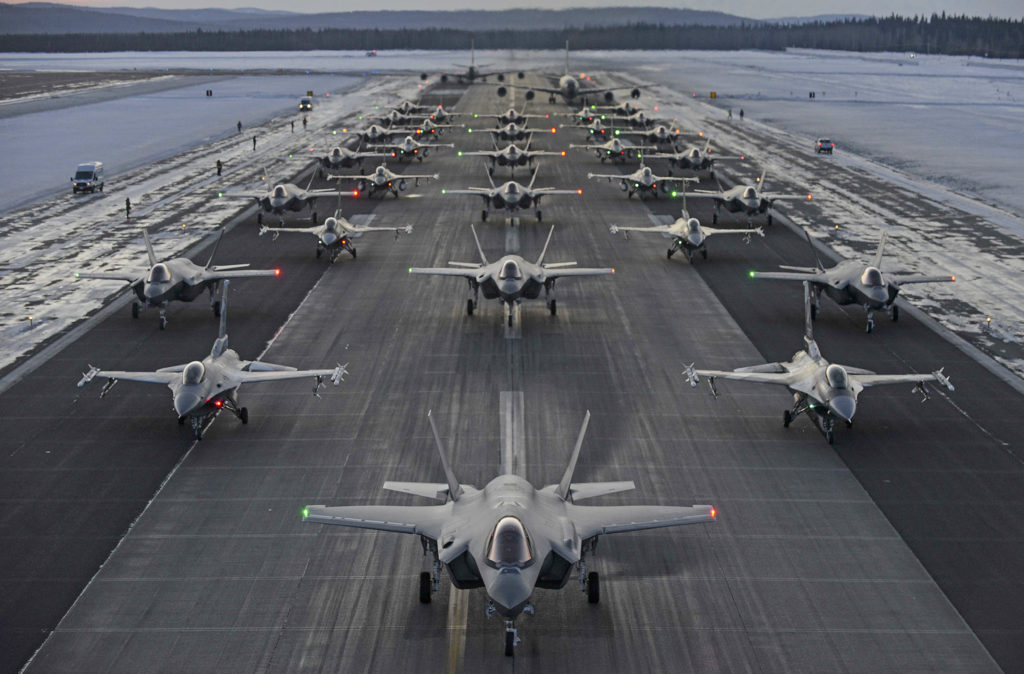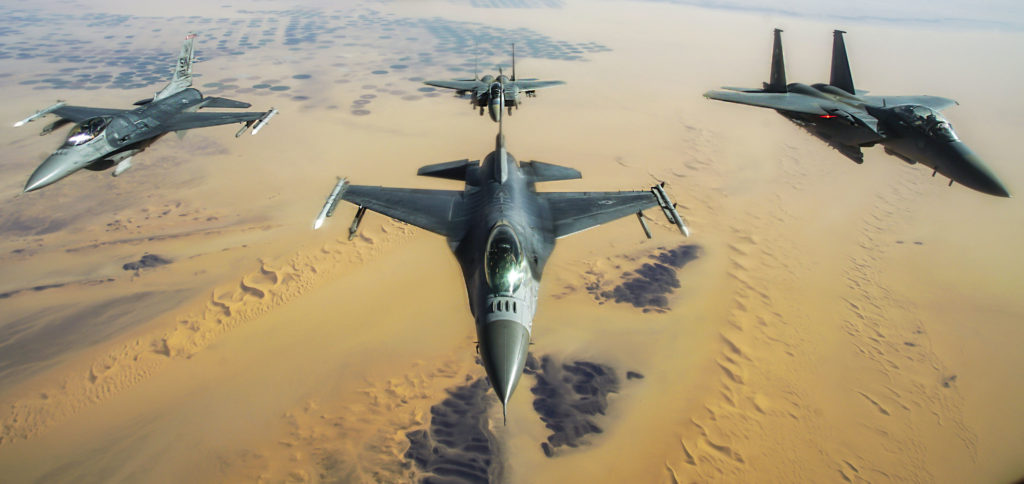Estimated reading time 14 minutes, 2 seconds.
The U.S. Air Force (USAF) is progressively overturning its long-held ambition to operate a fighter fleet comprised solely of fifth-generation stealth aircraft. The commander-in-chief has announced that he is launching a new study of the Air Force’s tactical fighter fleets that could result in expanded plans to blend “legacy” fourth- and fifth-generation fighters to meet a range of mission sets. Speaking on Feb. 17, USAF Chief of Staff Gen Charles “CQ” Brown told the Defense Writers Group that a new Tactical Aircraft (TacAir) study will be completed in time to inform the fiscal year 2023 budget request. “In the budget for FY23, that’s where I see that we’ll really make some key decisions,” Gen Brown said.

The USAF’s most senior officer told reporters that the TacAir study will look at options including a “clean-sheet design” for a new “four-and-a-half-gen or fifth-gen-minus” fighter that would replace the USAF’s oldest F-16s. Will Roper, the former assistant secretary of the Air Force for acquisition, technology and logistics, told Aviation Week before he left his position in January that buying new F-16s could be an option. Gen Brown, a former F-16 pilot himself, added more detail, saying that instead of simply procuring new F-16s: “I want to be able to build something new and different that’s not the F 16 — that has some of those capabilities, but gets there faster and uses some of our digital approach.”
The USAF planned to recapitalize its “legacy” fleets of A-10 Thunderbolt IIs, F-15C/D Eagles, and F-16 Fighting Falcons with 1,763 stealthy F-35As from Lockheed Martin. The first divergence from that plan came last year when the USAF ordered an initial eight F-15EX Advanced Eagles from Boeing under a $1.2-billion deal, as part of the U.S. Fiscal Year 2020 defense budget. The USAF is set to procure at least 144 new F-15EX Eagles under an indefinite-delivery/indefinite-quantity (IDIQ) contract worth up to $22.89 billion, with the first 80 jets planned over the next five years.
The USAF has not purchased any new Eagles since the last F-15E Strike Eagle was built back in 2001. While the F-15EX decision drew criticism from some former senior officers who saw it as a retrograde step, USAF leaders say that it represents the most efficient and cost-effective means to replace weary F-15C/D Eagles. It now appears that the USAF is expanding its interest in the mix of fourth- and fifth-generation fighters, and is exploring other options to replace its so-called “Pre-Block” F-16s from the 1980s. This equates to approximately 230 Block 25 and Block 30 F-16C/Ds that are earmarked for replacement in the next few years.

In parallel, the USAF is already working on its Next-Generation Air Dominance (NGAD) fighter, but Gen Brown also recognizes a need for “a mix for the lower-end fight,” along with its fleet of fifth-generation F-22A Raptors and F-35A Lightning IIs. The fighter review means the USAF could end up with a mixture of A-10s, F-15Es, F-15EXs, F-16s, F-22As, F-35As, NGAD, and a new model of F-16, or a clean-sheet alternative.
The revelation about potentially increasing the fourth-generation fighter fleet comes amid an undercurrent of concern regarding the F-35. While initial procurement costs of the stealthy fighter have come down, operation and support costs of the F-35 remain high. Before he vacated his post, Roper made no secret of the USAF’s frustration over Lightning II sustainment costs. Lockheed Martin is working to reduce the average cost per flight hour of the F-35A to $25,000 by 2025. Roper told reporters on Jan. 14, 2021: “I think it’s a long way from being an affordable fighter that we can buy in bulk.” He added: “That’s why other tactical aviation options are appealing to have in the mix so that the Air Force has options. There’s competition. There’s pressure on industry to improve.”
Air Force Magazine reported that Gen Brown spoke in February about ongoing engine wear issues with the F-35A, and that this will factor in the TacAir review. He said that issues with the Pratt & Whitney F135 engine are a result of their “high use rate.” In January, Bloomberg reported that F-35A engines have been running hot, “close to the limits of their design, and that heat has caused premature cracks, or delamination, of turbine blade coatings.” It seems that simply using the F-35 less is an option that Gen Brown is considering. “I want to moderate how much we’re using those aircraft,” he said on Feb. 17. “This is our ‘high end’ [fighter aircraft], we want to make sure we don’t use it all for the low-end fight.”

It marks a stark contrast to the notion that the F-35 will be all things for all missions across the tactical aircraft fleet. In fact, the Air Force Warfighting Integrating Capability (AFWIC) is at the center of a new fighter roadmap that abandons the notion that only stealthy fighters can provide a meaningful capability to the USAF’s Combat Air Forces. Instead, it argues that “legacy” platforms such as the F-15 and F-16 can play a critical role in the overall force mix. This has in turn led to a re-evaluation of how many fighters are actually required. Aviation Week reported in late 2020 that AFWIC’s plan by the end of 2018 had “capped F-35A deliveries at about 1,050 jets.”
Gen Brown’s comments regarding “what is the right force mix,” could open the door to another F-15EX-type “legacy” acquisition. The USAF has not ordered any new F-16s from Lockheed Martin for two decades. However, the fighter remains in production in Greenville, South Carolina, where Lockheed Martin moved its assembly line in 2019 to support international demand. It has also developed — thanks to strong international customer support — an advanced new Block 70/72 variant with some of the latest fighter technology. It closely mirrors how the Advanced F-15 was grown and matured by Boeing, thanks to international customer funding.
Skies reached out to Lockheed Martin, who issued this statement: “We are proud to partner with the U.S. Air Force across our portfolio, and we look forward to continuing to support warfighters’ mission needs. Many Lockheed Martin products, including the F-35, F-16 and F-22, form the backbone of the U.S. Air Force fighter fleet and will continue to do so for decades to come. The F-16, F-22 and F-35 together serve critical roles in missions in the U.S.; and the F-16 and F-35 fly together around the world.”

While Roper talked about potentially buying new F-16s, Gen Brown appeared to back away from this suggestion, saying that the “Viper” lacks open mission systems capability, and it still has an old school approach to operational flight program updates, which lack the kind of operational agility the USAF desires. There’s no reason why Lockheed Martin couldn’t address some of these issues through upgrades to the F-16 Block 70/72, while also tapping into available F-35 technology, to produce an “F-16EX-type” derivative. Boeing is doing just that with the Open Mission Systems processor that it is adding to the F-15EX for the USAF that will enable it to react to near-real-time software updates to meet emerging threats.
However, Gen Brown is not ruling out starting from scratch. “I want to be able to build something new and different, that’s not the F-16,” he said. “I want to entertain a clean-sheet design of something that’s not necessarily fourth-gen, but may not be completely fifth-gen either. There’s some other low-end type things in our high-end fight.” He added: “If we have the capability to do something even more capable for cheaper and faster, why not? Let’s not just buy off the shelf, let’s actually take a look at something else out there that we can build.”
This approach leans towards Roper’s vision for a “Digital Century Series” of fighters. Fleets of new jets, produced with model-based design and digital engineering, that move from concept to flight line in an efficient and expedited manner — along the same lines as Boeing’s T-7A Red Hawk advanced jet training aircraft. When the USAF’s T-X competition was launched, few thought that a brand new design could eclipse an off-the-shelf solution — but that’s exactly what happened. The T-7 was able to match the exact capabilities the USAF required, and beat the opposition on price.

What is certain is that the USAF is facing budget pressures, and it needs to tackle the high cost of operating the F-35 head-on, while maintaining a balanced overall force. Gen Brown’s fiscal and operational challenges go far beyond just fighters, with a range of fleets that are in urgent need of replacement. He acknowledged that the USAF is unlikely to be able to afford the goal of growing from 312 to 386 operational squadrons by 2030, which was the vision of his predecessor Gen Dave Goldfein. However, he said: “I want to . . . get as close as I can to a 386 capability with the force size I have and [the] dollars available.”
A balanced fighter fleet, with a mix of assets that offer a scalable solution to the needs of the combatant commanders, must be the optimum solution. These range from a “night one” force to kick-down the door in a high-threat theater, to aircraft providing armed overwatch in a close air support “wagonwheel” over the battlefield in a permissive environment. Gen Brown has thrown down the gauntlet in a most dramatic fashion, inviting a range of options and some radical thinking to help sketch out the future of the world’s most powerful air force.









He is talking about a SAABs 39 Gripen E/F+ developed together with Boeing and manufactured in USA.
It would appear the Gripen E/F fits the stated requirement. Are you speculating Bengt or is your comment based on some inside knowledge?
The Air Force should just buy more F-16Vs.